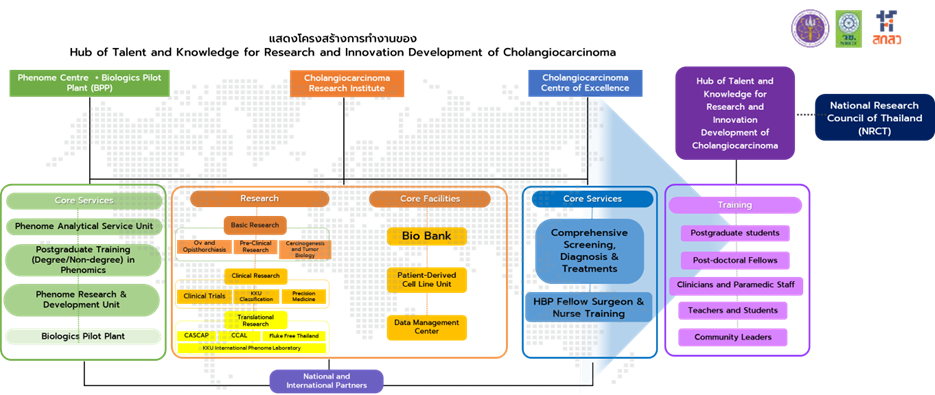Background
The World Health Organization has classified the liver flukes Opisthorchis viverrini and Clonorchis sinensis as parasites that can cause bile duct cancer in humans. In this regard, liver fluke disease is also an important public health problem that is not only found in outbreak sources in the northeast and northern regions of Thailand. But it is also a serious public health problem in Cambodia, Laos, Burma and Vietnam (CLMV countries). It has been found that more than 40 million people in the Mekong Subregion are infected with liver fluke (representing 20 percent of the population) This is because these people still like to consume raw fish and live in the watershed area of the lower Mekong Basin.
Bile duct cancer Cholangiocarcinoma is cancer caused by abnormalities of bile lining cells both inside and outside the liver. It has been found that approximately 10,000 - 20,000 Thai people die from bile duct and liver cancer per year, with more than half of them being from the northeastern region. Knowledge from research results from Khon Kaen University has been applied to prevention, search, and surveillance to find cancer patients in the early stages. in order to receive timely treatment Because approximately 55 percent occur in working-age people who are heads of families between 40-60 years of age, which is considered a serious disease and causes great economic, social, and quality-of-life losses for people in society. And even though public health agencies have continued public relations campaigns and knowledge on prevention and control of liver fluke disease, It even caused the outbreak of liver fluke disease in Thailand to decrease sequentially from 36 percent in 1988 to 10 percent in 2002. But in reality, it was found that the frequency of liver fluke infection among people There is great variation. In particular, parasitic infections around fresh water sources have found that the incidence of bile duct cancer in patients over 40 years of age has not decreased, with variations ranging from 2 percent to 70 percent. Statistics on the incidence of the disease range from 93. – 318 people per 100,000 people per year
Mission and Vision
The Hub of Knowledge for Research and Innovation Development of Cholangiocarcinoma will coordinate national and international cooperation to carry out research. Create knowledge Innovation and technology along with training Transfer knowledge Innovation and technology in preventing, diagnosing and treating liver fluke and bile duct cancer in the public in a comprehensive manner from the primary level emphasizing disease prevention and control. The secondary level focuses on screening and monitoring disease occurrence. and tertiary care that focuses on diagnosis and treatment of disease. All 3 levels of operations are connected with a large database system (Big Data System) that can be used to track and evaluate work in real time, which is an extension of the operations of the Cholangiocarcinoma Research Institute. Khon Kaen University already and work will be in an integrated manner (Trans-disciplinary research) because it consists of doctors who are experts in various fields. These include surgeons, internists, radiologists, pathologists, family medicine doctors, etc., as well as scientists and researchers with expertise in all fields from various faculties. Including the Faculty of Medicine Faculty of Public Health Faculty of Veterinary Medicine Faculty of Agriculture Faculty of Science Faculty of Engineering Faculty of Education Faculty of Humanities and Social Sciences Both inside and outside Khon Kaen University including other world-class research institutes such as Imperial College London, University College London, University of London, University of Edinburgh, University of Manchester, University of Tokyo, Keio University, Mie University, National University of Singapore, Swiss Tropical and Public Health Institute. The working model of the Cholangiocarcinoma Research Institute has been proven to be able to work towards solving problems with good results. including being able to develop researchers Thai and international scientists, experts, instructors, and students who can come work/study in the Hub of Knowledge for Research and Innovation (Hub of Knowledge for Research and Innovation) Development of Cholangiocarcinoma)
Objective
It is a center for producing research results. Create new knowledge and innovations related to bile duct cancer. which is of medical and academic benefit both at the national and international level, being a center for transferring knowledge and innovations used in solving the problem of bile duct cancer at the national and international level


 Background
Background Mission and Vision
Mission and Vision Objective
Objective Work Structure
Work Structure